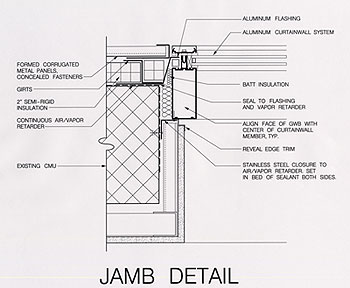Architectural Aluminum Curtain Wall Systems
"Fenestration Beyond Standards
Successfully integrating windows, storefronts, and curtain
walls
by David W. Altenhofen, CSI, CCS, AIA
Reprinted with permission of The Construction Specifications
Institute
99 Canal Center Plaza, Suite 300, Alexandria, VA 22314, from
The Construction Specifier
Note these standardized test procedures and specifications do not establish the performance values required for a project, which must be determined by the architect. He must carefully specify the performance levels without over-specifying and driving up project costs. It is unreasonable on most projects to perform custom laboratory testing on mock-ups of the project design. As such, the architect must interpret test results provided by the manufacturer from standard assemblies or from similar, previously tested assemblies, requiring a further level of interpretation and interpolation. The discrepancies between the system required for the project and the tested one may be substantial.
Standards for glass also tend to set a standardized test method or minimal performance, but do not necessarily establish fully adequate performance. ASTM E 1300, Standard Practice for Determining Load Resistance of Glass in Buildings, sets the method for determining the structural performance of glass, but the architect or engineer must set the actual performance criteria. Some of the variables they have to juggle include substantial snow/drift loads on skylights, high wind loads at corners, simultaneous positive/negative wind loads on canopies, or limited allowable deflection to minimize visual distortion.
|
|
ASTM E 774, Standard Specification for the Classification of the Durability of Sealed Insulating Glass Units, establishes standards for insulated glass (IG) units, but a variety of options are not included in the standard. Several different types of primary and secondary seals are allowed, which may not be compatible with adjacent glazing sealants. Likewise, fine details, like the color of the spacer or special spacers to improve thermal performance, are not included.
National Fenestration Rating Council standard NFRC 100, Procedure for Determining Fenestration Products U-Factors, establishes the method measuring U-values of IG units while NFRC 200, Procedure for Determining Fenestration Product Solar Heat Gain Coefficient and Visible Transmittance at Normal Incidence, establishes how solar heat gain coefficients are measured, but does not give any performance values. The architect must select the appropriate values to meet energy codes and match the assumptions used by the mechanical engineer in the design of the HVAC system. Problems will arise when only the standard is referenced without providing performance values, particularly when the contractor submits an inferior product.










